From The CRPG Addict
Total Hours: 1
Difficulty: Moderate (3/5), partly user-definable
Final Rating: (to come later)
Ranking at time of posting: (to come later)
 |
| A tavern tale hints at a bigger plot to come. |
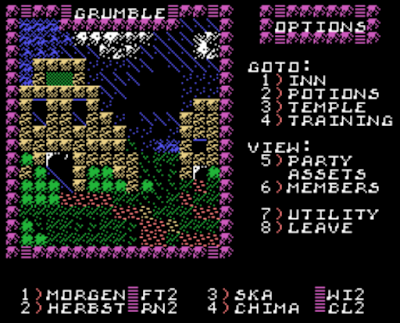 |
| Options in town. |
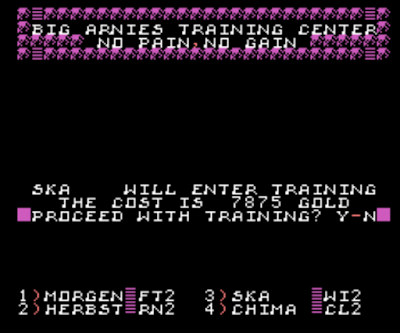 |
| Sure, that will only take me about 70 combats to earn. |
Movement is accomplished with the ESDX cluster, with a few other keys to perform special actions inside and outside of combat. The game checks for random encounters based on a number of cycles rather than the number of moves. This is highly annoying. Not only are you penalized for not immediately moving the moment that you have the ability (after a few seconds, the game inevitably rolls a random encounter), but in the modern era you can’t crank up the emulation speed to get other things to run faster unless you’re prepared to deal with all the extra combats.
Combat hasn’t advanced at all since the first game. It’s basically Phantasie‘s system without the little character animations. There are only a couple dozen enemies in the game. Upon meeting an enemy party, you can choose to fight, intimidate them, greet them, surrender to them, or flee. Anything other than “fight” gives the enemy a free round of attacks if it fails. “Intimidate” is a great option. If it succeeds–which it does enough to make it viable–you still get the experience and gold from the combat, without having to fight anything.
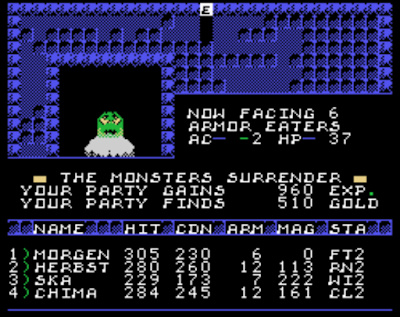 |
| I’m glad I didn’t have to fight these guys. They eat armor. |
If you choose to fight, you have options to thrust, parry, lunge, or cast a spell. Actions execute immediately instead of waiting until everyone sets up. The spell selection is small–eight each for wizards and clerics and six for rangers–and they can only be cast in combat. As in Phantasie, many are simply variants in power of the same base spell; for instance, the wizard gets “Firestorm1,” “Firestorm2,” and “Firestorm3.” There are no mass-damage spells, which I somewhat like, as it makes me more likely to cast buffing spells like “Strength,” “Protection,” and “Prayer” in combat.
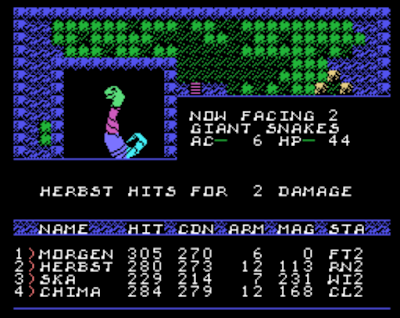 |
| Fighting a cute giant snake. |
Dungeon exploration offers the same weird dichotomy as in Legends, where half the dungeons offer traps and treasure chests but no monsters, and the other half offer monsters but no traps or chests. The first type of dungeon is attached to Grumble and is the first one that you explore. Legends started with some of the dungeon levels exposed, but the sequel makes you move to find every available square. It doesn’t even open up the squares around you; you have to actually move into walls to see if you can go that way.
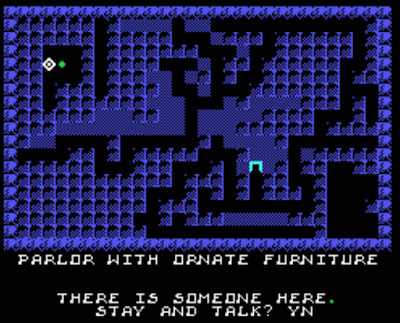 |
| Threading my way through the dungeon. The dot indicates a special encounter. |
Chests are often trapped and have to be disarmed. They might hold gold, potions, or equipment. You have to keep careful track of your current weapon, armor, and shield because when you find something new, you don’t have an option to review what you’re already carrying before deciding whether to keep it or leave it. One trip through the starter dungeon mostly made up for the paltry equipment my characters imported with.
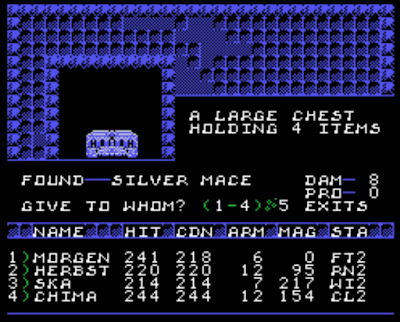 |
| I think most of my guys have better weapons than this. |
The pair of games does a good job with narratives and encounters that develop the backstory and propel the main quest. I wish more titles of the era, independent and commercial, rewarded exploration with an occasional bit of text. (A text card like the one below at the end of each Shadowkeep level would have incentivized continuing to play it.) Grumble’s tavern offers hits of gameplay elements to come. Rooms and hallways in dungeons have brief descriptions, and special encounters, annotated with a dot, sometimes offer role-playing options.
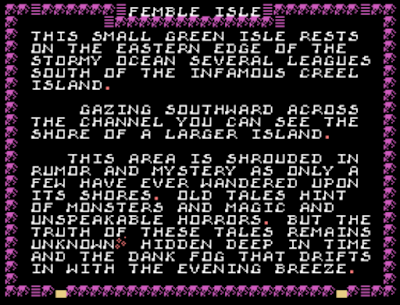 |
| A signpost on the starting island. |
An intertitle at the beginning of the Grumble dungeon explains that it’s used for storage as well as the city’s famous water and sewer system. As you explore, you repeatedly encounter a guide leading people through the sewers. On Level 2, there’s a maintenance man who sells some tools to the party, and on Level 4, you run into the city’s mayor, in hiding from assassins, who gives you a key to a special room at the Zen Outpost.
 |
| If Crusaders of the Dark Savant presented its text like this, I’d have a lot less of an issue with it. |
Back on the surface, the tools are necessary to repair the drawbridge connecting the starting island to the next one to the south. I know from peeking at the map on Adamantyr’s site that the game world consists of an absurdly long chain of islands running from north to south, none wider east-west than a single game screen but occupying perhaps 13 screens vertically. Apparently, Donn Granros has said that players of Legend complained of the open-world nature of the first game, so in this one the authors decided to feed them the dungeons in a linear order.
 |
| Good thing we bought those tools! |
The problem with this approach is that you can only level up and heal in Grumble. And while you can quit and save in camp in the wilderness, every time you reload, you’re back in Grumble. This is going to get annoying towards the end of the game when I’m far afield, want to save to avoid losing progress, but then have to trek all the way back to my position from Grumble again. (And the Classic99 emulator doesn’t offer save states, so I can’t cheat this process.) The overall setup seems to suggest that, once again, the player is best off doing a lot of grinding near Grumble before heading out into the open world. Fortunately, as long as you check in once in a while, grinding is as easy as weighing down the “1” key, since that key acknowledges messages, choose to fight, and chooses the “thrust” action each round.
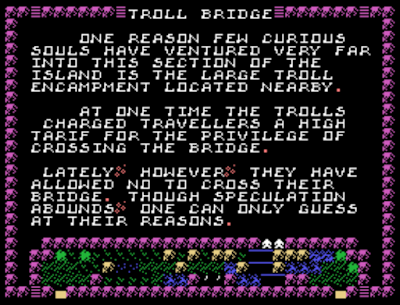 |
| Signs warn of strange happenings to the south. |
I’ve explored about four screens to the south. It appears there are going to be special encounters at a lot of the bridges. I found the second dungeon–a monster one, this time. But I’m relying on the idea that all dungeons are visible on the screen and don’t require you to poke around the map. Anyone who’s played the game–which is probably just Adamantyr–please let me know if I’m wrong about this.
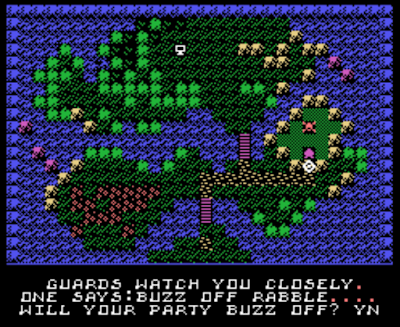 |
| It’s a tough call, but I’m thinking “no.” |
Just like its predecessor, Legends II is not a fantastic game, but it’s one of the few fully-developed RPGs for the TI-99, and it offers enough of interest to keep me going. I look forward to seeing how or if the story develops and what the main quest truly is. One of the tavern tales suggests that Ashtar Creel isn’t really dead, and another says, intriguingly, that “they somehow snatched this great king from a parallel world,” likely to hold him for ransom. Are we going to end up rescuing Lord British in a non-Origin game?
Time so far: 4 hours
Original URL: http://crpgaddict.blogspot.com/2018/10/game-306-legends-ii-1989.html

